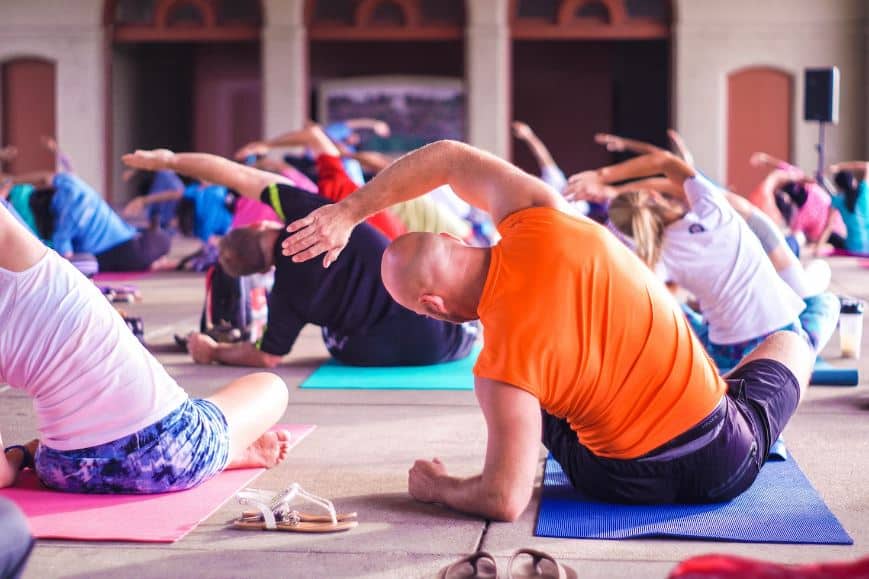I guide my students into tree pose on the right side, standing at the front of the room, demo-ing the pose for them as I speak.
Find your drishti, and as you find your balance draw your hands to heart centre, moving slowly.
As I cue the students to move slowly and with their breath, I see a student in the back of the room shoot up into tree pose, sending her arms to the sky quickly, and then immediately topple over.
By the time I have cued students to reach their arms to the sky if (and only if) they feel balanced, she has toppled over 3 times.
I can feel her frustration.
I encourage her (and the rest of the class) to practice self-compassion.
Balance is different EVERY SINGLE DAY, so it’s important to practice compassion for yourself if your balance is off today. Remember, you are only human.
I step to the back of the room out of sight of the students as I guide them into tree on the other side.
I watch her shoot up like a jack-in-the-box on the left side, and then topple over again and again. I continue to cue slow movements at the pace of the individual breath, and encourage the practice of self-compassion. Her breath is heavy and ragged, and she sighs loudly, letting her frustration become known to the room.
I can’t help but think to myself that if she would just listen to me and move slowly she wouldn’t keep toppling over.
Come out of tree pose slowly, releasing your left foot to the ground, and then shake it out. Close your eyes and take a moment to tune-in in tadasana. Balance poses can be extremely difficult at times, and it’s important not to beat yourself up if you have a bad balance day.
We flush it out with a vinyasa, and continue on with the practice.
She smiles, waves, and leaves like any other day, and I am left feeling perplexed by this woman. She regularly attends my classes, even though she often doesn’t listen to my cues.
Why does she keep coming? And, why isn’t she listening? Does she even like my classes?!
I headed home feeling frustrated and wondering why people come to yoga if they aren’t there for the right reason.
The first time I met this particular student, she approached me and told me, “I like a hard class.”
I smiled and nodded politely, and added in a couple extra minutes of forearm plank to the practice. Your welcome, Miss “I like a hard class”.
As I think these thoughts, I realize how un-yogi they are. I aim to create a space of non-judgment and openness for my students, yet here I am judging a student for what she wants out of the practice. I hear her request as an insult to my teaching style, instead of taking it as though she had asked me if we could do shoulder openers or hip openers.
The difference between asking for a hard class and asking to open the hips lies in my core beliefs as to what yoga should be about and why we should practice yoga.
I believe in moving with your breath, aligning your body in a way that feels good, and coming to a place of mental clarity.
I believe that strength, energy and endurance are side affects of moving with your breath and tuning into your body. I believe that when you practice the proper alignment of a chataranga time and time again, the strength comes. If I want a “workout”, I go to the gym or Crossfit. Yoga is a mental workout that happens through the physical practice.
And that is the reason I continue to show up on my mat.
What I have realized is that I was putting my reason for practicing yoga on my student, judging her for showing up to class for a reason that is different than my own.
The beautiful lesson that this particularly frustrating student has taught me is that there is no “right reason” for showing up to yoga. When you come to your mat, you are there for whatever serves you on that particular day, in that particular moment. Whether you show up for a sweaty workout, to clear your head, to build strengthen, to energize, to improve your core, to sit in child’s pose and cry, etc., you are there for the right reason. Whatever gets you to your mat is a good enough reason to be there.
As a yoga teacher, I get to share yoga with my students. I have the ability to share my beliefs around yoga and I can guide them in a way that serves me. What I have to remember, is that my purpose for practicing is not always going to be the same as my students, and just as I ask them to respect my reason for showing up and practicing, I have to respect theirs.




0 Comments